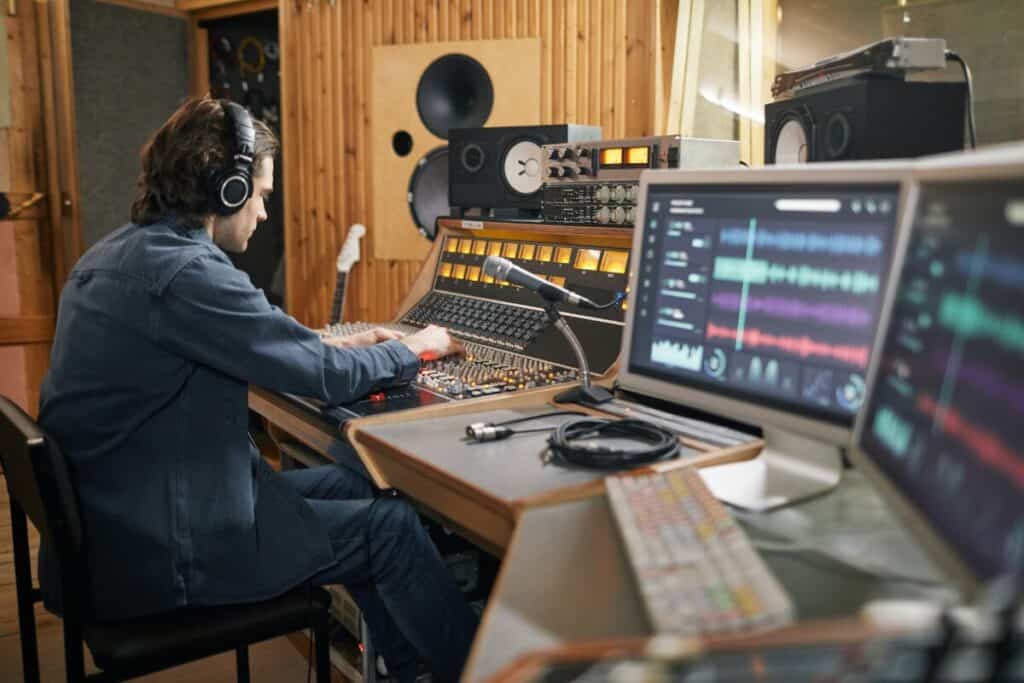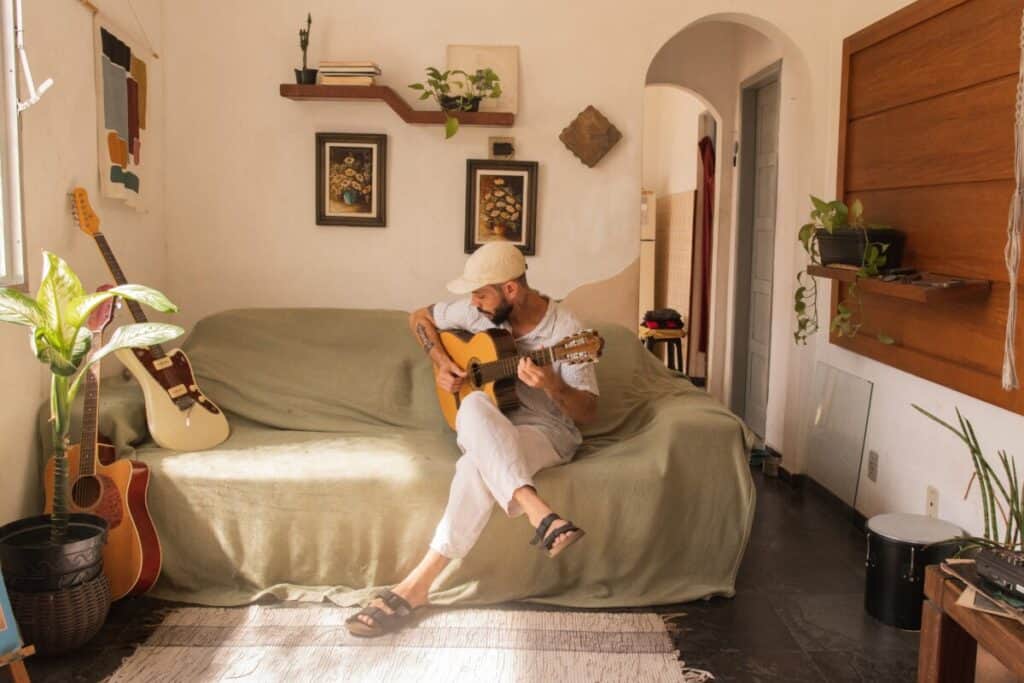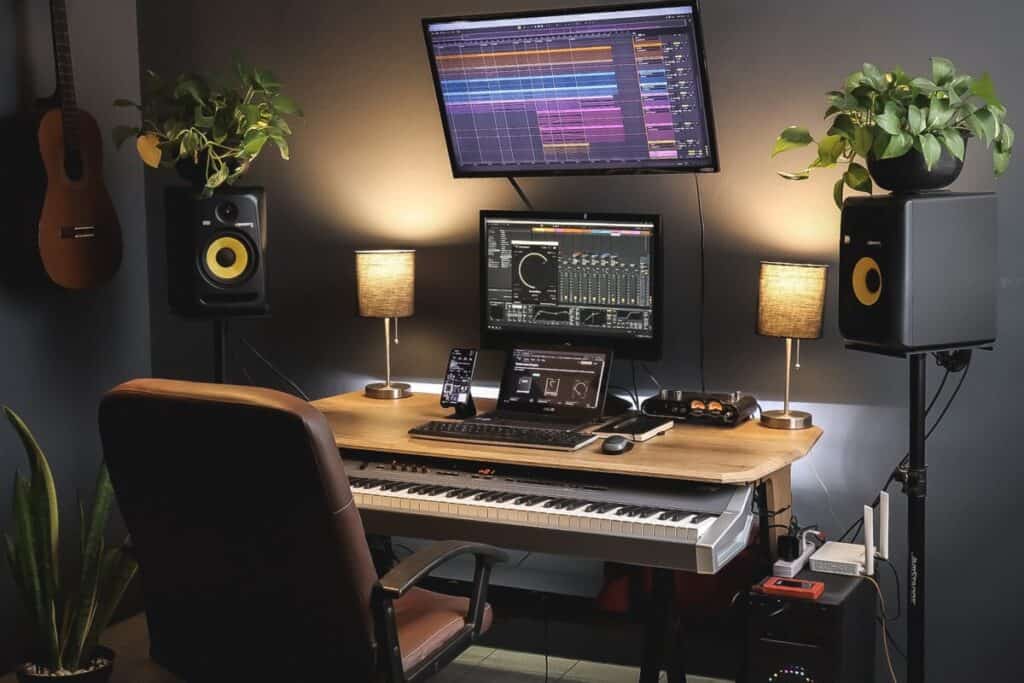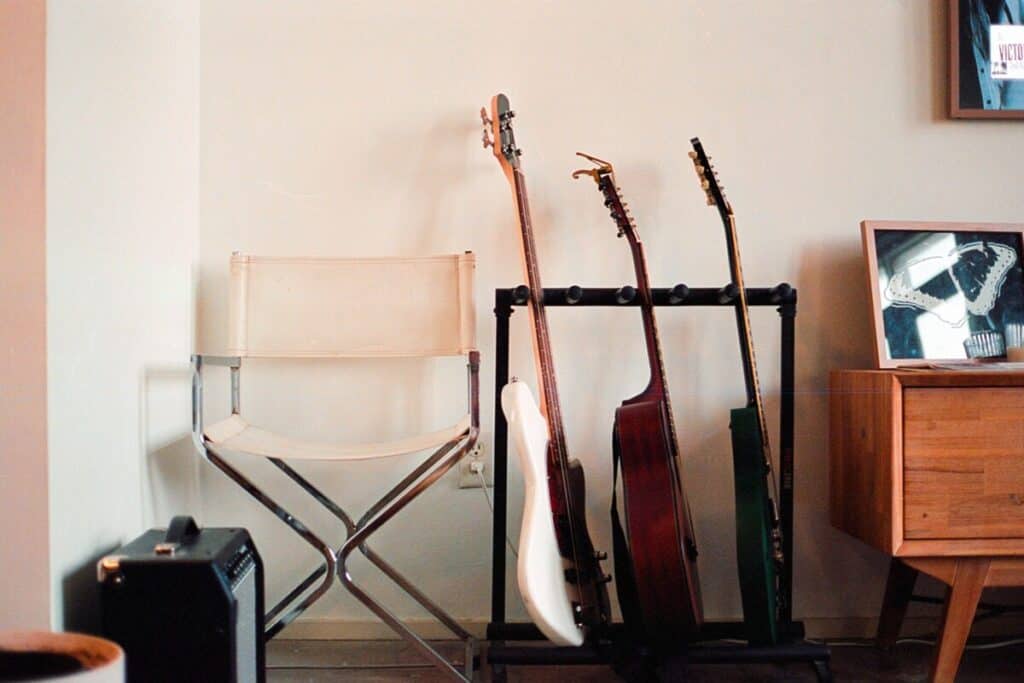Have you ever thought about the power of a well-decorated space? If you’re a musician, you’ve probably felt the magic that comes from recording in a studio that feels just right. After all, a home recording studio is more than just a place—it’s a sanctuary for creativity. Whether you’re an up-and-coming artist or a seasoned touring musician, setting up a home recording studio that inspires can make all the difference in your music journey.
But how do you go about turning a spare room into a haven for melodies? What if we told you that you can transform your workspace into a studio that not only sounds great but also reflects your unique style and personality? Well, that’s exactly what we’re here to help you with!
In this comprehensive guide, we’ll walk you through everything you need to know about decorating your home recording studio. From choosing the perfect theme to picking out the right furniture, from arranging inspiring artwork to selecting the best lighting—we’ve got you covered. Let’s dive into the world of music and decor and kickstart your journey to creating a studio space that truly sings with your spirit.
JUMP TO SECTION
- Choosing the Right Theme
- Picking Your Color Palette
- Furniture Selection
- Using Artwork and Photographs
- Lighting Your Studio
- Incorporating Rugs and Curtains
- Adding Life with Plants
- Utilizing Shelving for Display and Storage
- Soundproofing with Style
- Personalizing Your Space
- Wrapping up Your Studio Decoration

CHOOSING THE RIGHT THEME
First things first, let’s talk about themes. Just like a catchy melody or a soulful lyric, the theme of your home recording studio can set the tone for your creative process. It’s the vibe you’ll be soaking in every time you sit down to play, record, or even just think about music. So, it’s worth taking some time to choose a theme that resonates with you.
There are countless theme possibilities out there. You might lean towards a retro vibe, channeling the classic rock ‘n roll era with vintage posters and record players. Or perhaps a modern, minimalist look is more your style, with sleek lines and monochromatic colors. You could even go for a bohemian theme with cozy textiles and eclectic artwork. The key here is to choose a theme that feels authentic to you and resonates with the kind of music you’re creating.
As you embark on this journey of decorating your home recording studio, take a moment to think about what truly inspires you. What colors, textures, and styles stir up your creative juices? Remember, your studio is an extension of your artistic identity, so let it tell your story. Let’s dive into the next step where we’ll discuss picking your color palette, and remember, there’s no right or wrong here. It’s all about what makes you feel most at home in your musical haven.
PICKING YOUR COLOR PALETTE
Alright, now that you’ve picked a theme for your home recording studio, it’s time to dive into colors. The color palette you choose for your space can have a significant impact on your mood and creativity. Just as the right chord progression can evoke certain emotions in a song, the right colors can set the stage for your creative process.
Color psychology tells us that different hues can evoke different feelings. For instance, blues can be calming and promote focus, while yellows can evoke feelings of happiness and stimulate creativity. Reds can energize, and greens can create a sense of balance. When picking your color palette, think about the mood you want to create in your studio. Do you want it to be a serene sanctuary or a vibrant, energizing space? The colors you choose can help create this atmosphere.
Coolors.co is a handy online tool that allows you to generate and explore color palettes for your home music studio. With just a click, you can generate random color combinations or manually adjust the colors to your liking. You can lock specific colors you love and continue generating new palettes around them. Coolors.co simplifies the process of selecting a harmonious and appealing color scheme, helping you create a cohesive and inspiring environment in your home music studio.
And remember, implementing your color palette isn’t just about painting the walls. You can incorporate your colors through furniture, artwork, rugs, and even your musical equipment. Be creative and have fun with it!
FURNITURE SELECTION
With your theme in place and your color palette chosen, let’s move on to the next step in decorating your home recording studio: furniture selection. The right furniture can not only enhance your studio’s look but also provide you with the comfort you need during those long recording sessions.
Start by considering the essential pieces you’ll need in your studio. This could include a comfortable chair, a sturdy desk for your equipment, storage units for your musical instruments, and perhaps a cozy sofa for those well-deserved breaks. The style of these pieces should reflect your chosen theme and color palette. Don’t forget about comfort, too. After all, this is a place where you’ll be spending a lot of time creating and refining your music.
If you’re wondering where to find studio-appropriate furniture, there are plenty of options. Local furniture stores often have a range of styles to choose from. Online retailers, thrift stores, or vintage shops can also be gold mines for unique pieces that fit your theme.

USING ARTWORK & PHOTOGRAPHS
Now that your furniture is in place, let’s talk about using artwork and photographs in your home recording studio. Visuals aren’t just for show—they play a crucial role in sparking creativity and making your space truly feel like your own. They can transport you, inspire you, and serve as reminders of your musical journey.
When it comes to selecting artwork and photographs, think about what moves you. Maybe it’s album covers from your favorite bands, photographs from memorable concerts, or abstract paintings that resonate with you. You could even include personal photos that remind you of why you started making music in the first place. The sky’s the limit here!
Arranging your chosen visuals can also be a creative process. You might group them on a gallery wall, display them on shelves, or scatter them throughout the room for surprises at every corner. Remember, this is your space—let it tell your story and fuel your creativity. Next up, we’ll be exploring the world of lighting and how it can transform your studio.
LIGHTING YOUR STUDIO
Alright, we’ve made it to an often overlooked but super important part of setting up your home recording studio: lighting. Just like a well-mixed track, the right lighting can set the mood and make your space truly shine. It’s not just about visibility—it’s about creating an environment that inspires your best work.
There are different types of lighting to consider. Ambient lighting provides general illumination for the room. You might achieve this with ceiling fixtures or floor lamps. Task lighting, on the other hand, is focused light for specific tasks, like mixing tracks or reading sheet music. This could come from a desk lamp or adjustable sconces. Lastly, accent lighting can highlight artwork or architectural features in your studio.
When choosing lighting fixtures, keep your studio’s theme and color palette in mind. The arrangement of your lighting should also be considered, ensuring all areas of your studio are well-lit, from your mixing desk to your cozy break corner.
INCORPORATING RUGS & CURTAINS
With your studio shining bright, let’s step into another key aspect of decorating your home recording studio: incorporating rugs and curtains. These items aren’t just about aesthetics—they also have a dual function. They can dramatically improve the acoustics of your space while adding style and warmth.
Rugs and curtains can help dampen echoes and absorb sound, creating a better acoustic environment for recording and mixing. This is especially true for rooms with hard surfaces like wood or tile floors. But don’t just think about functionality. The style, color, and texture of your rugs and curtains should align with your chosen theme and color palette.
Check out these 5 Reasons Why Musicians Use Rugs on Stage and in the Studio.
When placing your rugs, consider areas where sound reflection may be an issue, such as beneath your desk or instruments. As for curtains, heavier materials can absorb more sound, making them a great choice for windows or even as a stylish room divider.

ADDING LIFE WITH PLANTS
We’re making great progress on decorating your home recording studio! Now, let’s talk about adding life to your space with plants. A touch of green can do wonders for your studio, creating a calming atmosphere and even improving air quality.
Plants aren’t just visually appealing. They can also absorb noise, making them a natural choice for improving acoustics in your studio. Plus, they’re known to reduce stress and boost mood—perfect for those moments when you’re searching for the next note or wrestling with a tricky mix. But we know you’re busy making music, so let’s focus on low-maintenance plants.
Consider easy-care plants like snake plants, pothos, or ZZ plants. They can thrive in various light conditions and don’t require frequent watering. Another option is a spider plant, known for its air-purifying qualities. Whichever plants you choose, they’re sure to bring a bit of the outdoors into your studio and keep your creative juices flowing.
UTILIZING SHELVING FOR DISPLAY & STORAGE
Now that your home recording studio is starting to bloom with the addition of plants, let’s turn our attention to shelving. Shelving can serve a dual purpose in your studio: it provides a place to display your musical items and offers much-needed storage space.
Shelves can hold everything from your record collection to your favorite books on music theory. They can also house smaller musical instruments or equipment, keeping your space organized and clutter-free. When arranging items on your shelves, think about balance. Mix and match different types of items for a visually appealing setup that also tells a bit about your musical journey.
As for the shelving units themselves, consider options that align with your chosen theme and color palette. Floating shelves can create a clean, modern look, while industrial-style shelving units might suit a more rustic theme.
SOUNDPROOFING WITH STYLE
We’re nearing the final stages of our studio decorating journey. Next on our list is something crucial for any home recording studio: soundproofing. Soundproofing isn’t just about keeping your music from disturbing the neighbors, it’s also about ensuring the sound within your studio is the best it can be.
Soundproofing involves minimizing the transfer of sound from one space to another. This can be achieved through materials that absorb sound, such as soundproofing panels. But how do you incorporate these practical items without disrupting your carefully crafted aesthetics? Well, we’ve got some tips for you.
Consider selecting soundproofing panels that match or complement your studio’s color palette. You could also arrange them in a pattern for a more artistic look. Some musicians even go the extra mile by covering panels with custom fabric that ties into their studio theme. So, you see, soundproofing doesn’t have to be all work and no play. Up next, we’ll discuss personalizing your space to truly make it your own. We’re almost there, let’s keep going!

PERSONALIZING YOUR SPACE
As we approach the final note in our symphony of decorating your home recording studio, let’s talk about personalizing your space. We’ve covered a lot of ground on the technical and aesthetic aspects, but it’s the personal touches that will make your studio feel uniquely yours.
Adding personal items to your studio can make it feel more comfortable and inspiring. Think about what motivates and inspires you. Is it a framed photo of your favorite musician or band? A vintage concert poster? Or perhaps it’s a cherished memento from your own musical journey. These are the kind of things that will make your studio not just look good, but feel good too.
End
Remember, your studio is more than just a place where you create music. It’s a reflection of your musical identity and journey. So, don’t shy away from letting your personality shine through. In our final section, we’ll wrap up and recap all the great work we’ve done. Keep the beat going—you’re doing awesome!
WRAPPING UP YOUR STUDIO DECORATION
Well, there you have it. We’ve strummed our way through the complete guide to decorating your home recording studio. From choosing the right theme to personalizing your space with items that reflect your musical journey, we’ve covered all the keynotes. Each element we’ve discussed not only enhances the aesthetics of your space but also contributes to the functionality and comfort of your studio.
Let’s do a quick recap. We started with the importance of choosing a theme that resonates with your personal style and music. Then, we dived into picking a color palette, selecting furniture, using artwork and photographs, and lighting your studio. We also highlighted the dual function of rugs and curtains, the benefits of adding life with plants, utilizing shelving for display and storage, and soundproofing with style. And finally, we emphasized the significance of personal touches in making your studio uniquely yours.
Decorating your home recording studio is a journey, one that’s meant to be as enjoyable and creative as the music you make. So, let this guide inspire you, but remember that there are no hard and fast rules. You’re the composer here. Create a space that not only sounds good but also feels good to you. Thank you for joining us on this journey. Now, go forth and make some music magic in your newly decorated studio!
RELATED QUESTIONS
How can I incorporate vintage music gear into my studio decor?
Vintage music gear can be a great aesthetic addition to your studio. You can use old amplifiers as side tables, hang vintage guitars on the walls, or display old microphones on shelves. Just make sure the items are securely placed to avoid any damage.
What are some tips for creating a relaxing and inspirational corner in my home recording studio for breaks between sessions?
Consider adding a comfortable chair or couch, a small coffee table, and some inspirational books or artwork. This space could also be a great spot for a record player and your favorite vinyl collection. Plants can also add a calming touch.
How can I maximize a small space when setting up my home recording studio?
Utilize wall space for storage and hang instruments to save floor space. Choose furniture that serves multiple purposes, like a storage ottoman or a desk with built-in shelves. Also, keep your setup simple, and don’t crowd your space with unnecessary items.
What are some creative ways to display my vinyl record collection in my studio?
You could use a wall-mounted rack or create a display shelf specifically for your collection. Another idea is to use album frames to showcase your favorite records on the wall. A vintage-style record stand can also be a great centerpiece.
How can I use mirrors in my home recording studio to enhance both decor and sound reflection?
While mirrors can be a stylish addition, they can also affect the acoustics of your studio because they reflect sound. Placing them strategically, such as in non-critical listening areas or areas where you want to increase the sense of spaciousness can work. Always consider sound treatment alongside aesthetics.
For more industry tips and music marketing hacks, check out Ennui Magazine. You can also follow us on Facebook, Twitter, Instagram, Pinterest, and YouTube.
